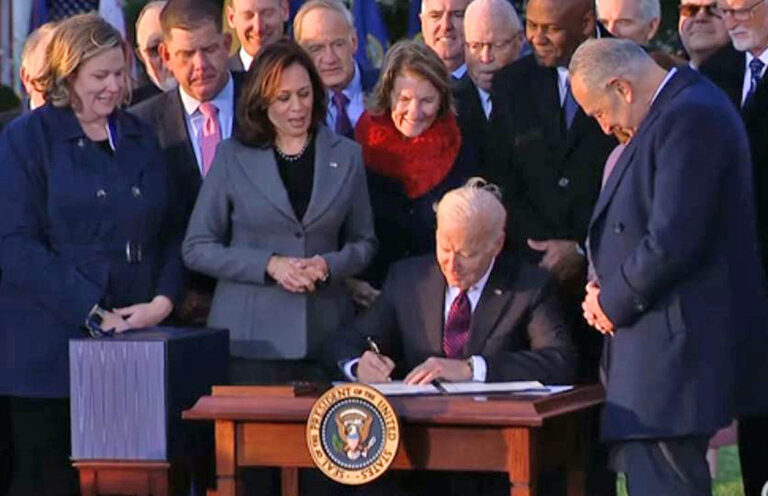WASHINGTON — President Joe Biden on Monday afternoon signed into law the largest-ever investment in the nation’s infrastructure.
From improved roads, cleaner water systems, faster high speed internet and new bridges to adding thousands of jobs and delivering improved environmental impacts, the sweeping $1 trillion bill has been touted by Biden and other government officials as a way to rebuild America’s infrastructure better and stronger than ever before.
“The world has changed, and we have to be ready,” Biden said from the South Lawn of the White House before a crowd of dozens. “The bill is proof that, despite the cynics, Democrats and Republicans can come together and deliver real results.”
Biden thanked everyone from his wife, Jill, to Vice President Kamala Harris, members of the bipartisan support group from the House and Senate, as well as governors, mayors and everyone else who supported the measure.
“We are taking a monumental step forward to build back better as a nation,” the president said as the crowd cheered. “Today, we are finally getting it done. My message to American people is this: America is moving again, and your life is going to change for the better.”
The plan promises to reach almost every corner of the country. It’s a historic investment that the president has compared to the building of the transcontinental railroad and Interstate Highway System. The White House is projecting that the investments will add, on average, about 2 million jobs per year over the coming decade.
The bill cleared the House on a 228-206 vote Nov. 5, ending weeks of intraparty negotiations in which liberal Democrats insisted the legislation be tied to a larger social spending bill — an effort to press more moderate Democrats to support both.
The Senate passed the legislation on a 69-30 vote in August after rare bipartisan negotiations, and the House kept that compromise intact. Thirteen House Republicans voted for the bill, giving Democrats more than enough votes to overcome a handful of defections from progressives.
Here’s a breakdown of what the infrastructure bill includes:
ROADS AND BRIDGES
The bill would provide $110 billion to repair the nation’s aging highways, bridges and roads. According to the White House, 173,000 total miles or nearly 280,000 kilometers of America’s highways and major roads and 45,000 bridges are in poor condition. The almost $40 billion for bridges is the single largest dedicated bridge investment since the construction of the national highway system, according to the Biden administration.
PUBLIC TRANSIT
The $39 billion for public transit in the legislation would expand transportation systems, improve accessibility for people with disabilities and provide dollars to state and local governments to buy zero-emission and low-emission buses. The Transportation Department estimates that the current repair backlog is more than 24,000 buses, 5,000 rail cars, 200 stations and thousands of miles of track and power systems.
PASSENGER AND FREIGHT RAIL
To reduce Amtrak’s maintenance backlog, which has worsened since Superstorm Sandy nine years ago, the bill would provide $66 billion to improve the rail service’s Northeast Corridor (457 miles, 735 km), as well as other routes. It’s less than the $80 billion originally sought by Biden — who famously rode Amtrak from Delaware to Washington during his time in the Senate — but it would be the largest federal investment in passenger rail service since Amtrak was founded 50 years ago.
ELECTRIC VEHICLES
The bill would spend $7.5 billion for electric vehicle charging stations, which the administration says are critical to accelerating the use of electric vehicles to curb climate change. It would also provide $5 billion for the purchase of electric school buses and hybrids, reducing reliance on school buses that run on diesel fuel.
INTERNET ACCESS
The legislation’s $65 billion for broadband access would aim to improve internet services for rural areas, low-income families and tribal communities. Most of the money would be made available through grants to states.
MODERNIZING THE ELECTRIC GRID
To protect against the power outages that have become more frequent in recent years, the bill would spend $65 billion to improve the reliability and resiliency of the power grid. It would also boost carbon capture technologies and more environmentally friendly electricity sources like clean hydrogen.
AIRPORTS
The bill would spend $25 billion to improve runways, gates and taxiways at airports and to improve terminals. It would also improve aging air traffic control towers.
WATER AND WASTEWATER
The legislation would spend $55 billion on water and wastewater infrastructure. It has $15 billion to replace lead pipes and $10 billion to address water contamination from polyfluoroalkyl substances — chemicals that were used in the production of Teflon and have also been used in firefighting foam, water-repellent clothing and many other items.
PAYING FOR IT
The five-year spending package would be paid for by tapping $210 billion in unspent COVID-19 relief aid and $53 billion in unemployment insurance aid some states have halted, along with an array of smaller pots of money, like petroleum reserve sales and spectrum auctions for 5G services.
The Associated Press contributed to this report.
The Trucker News Staff produces engaging content for not only TheTrucker.com, but also The Trucker Newspaper, which has been serving the trucking industry for more than 30 years. With a focus on drivers, the Trucker News Staff aims to provide relevant, objective content pertaining to the trucking segment of the transportation industry. The Trucker News Staff is based in Little Rock, Arkansas.








